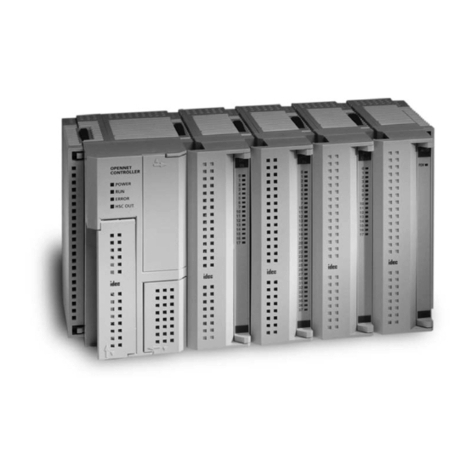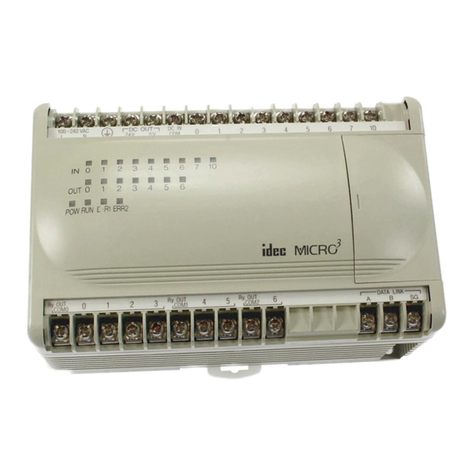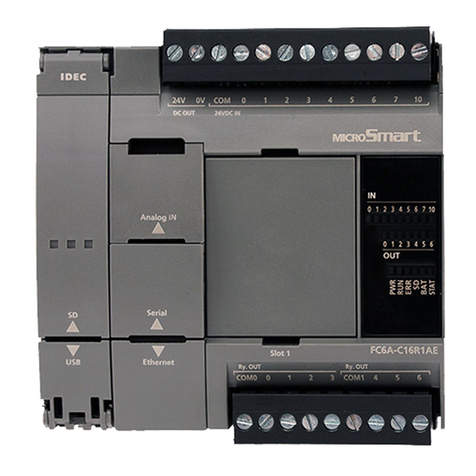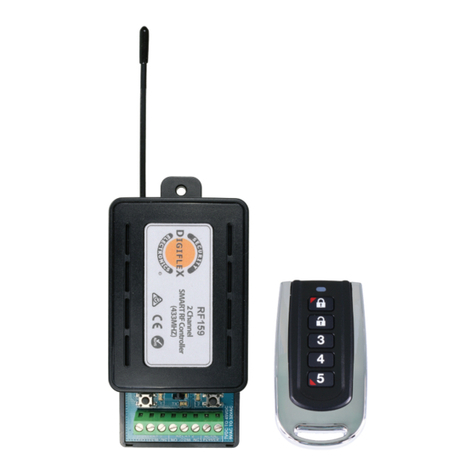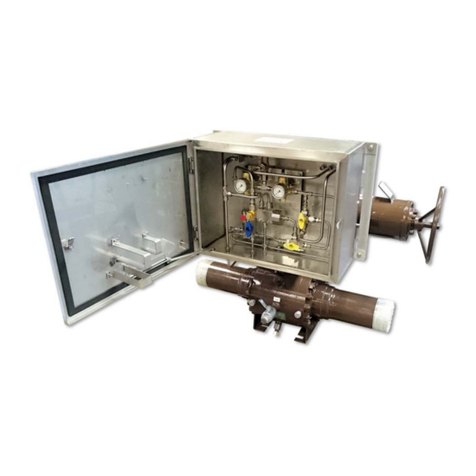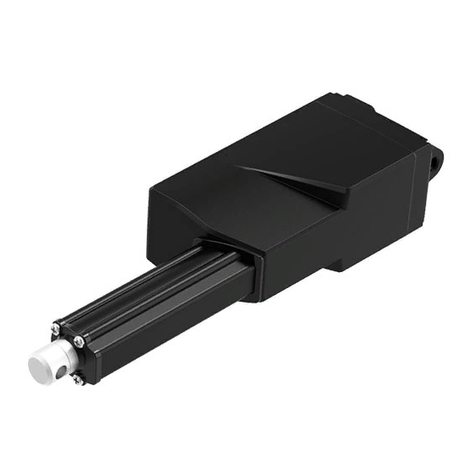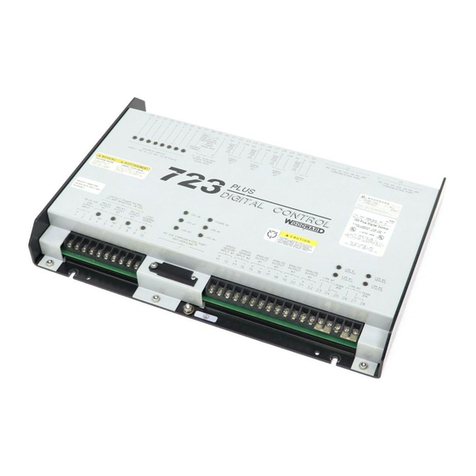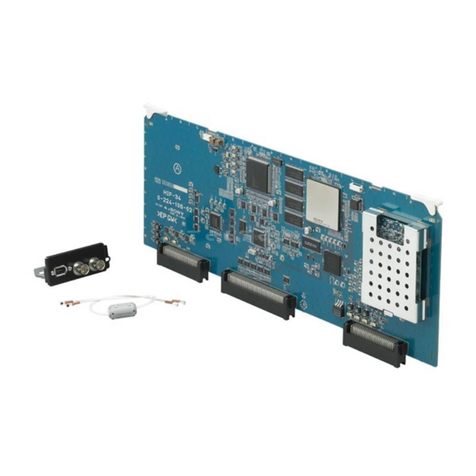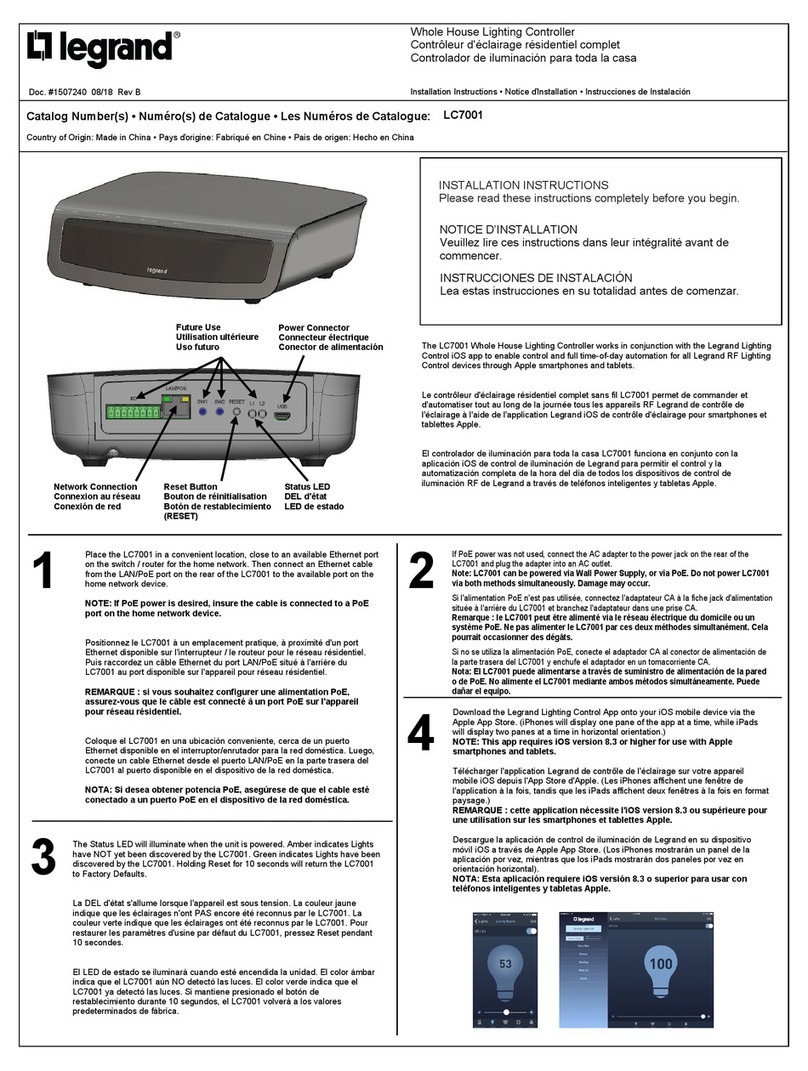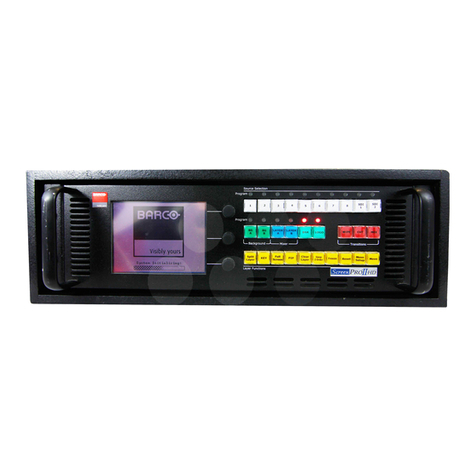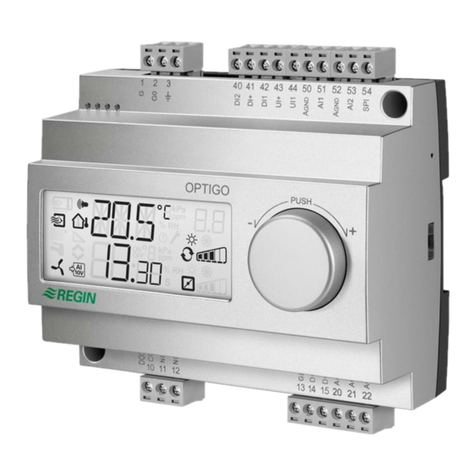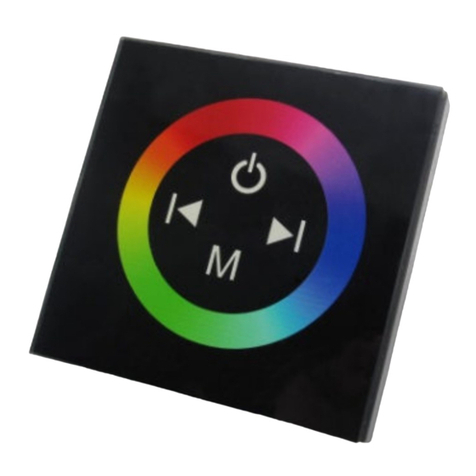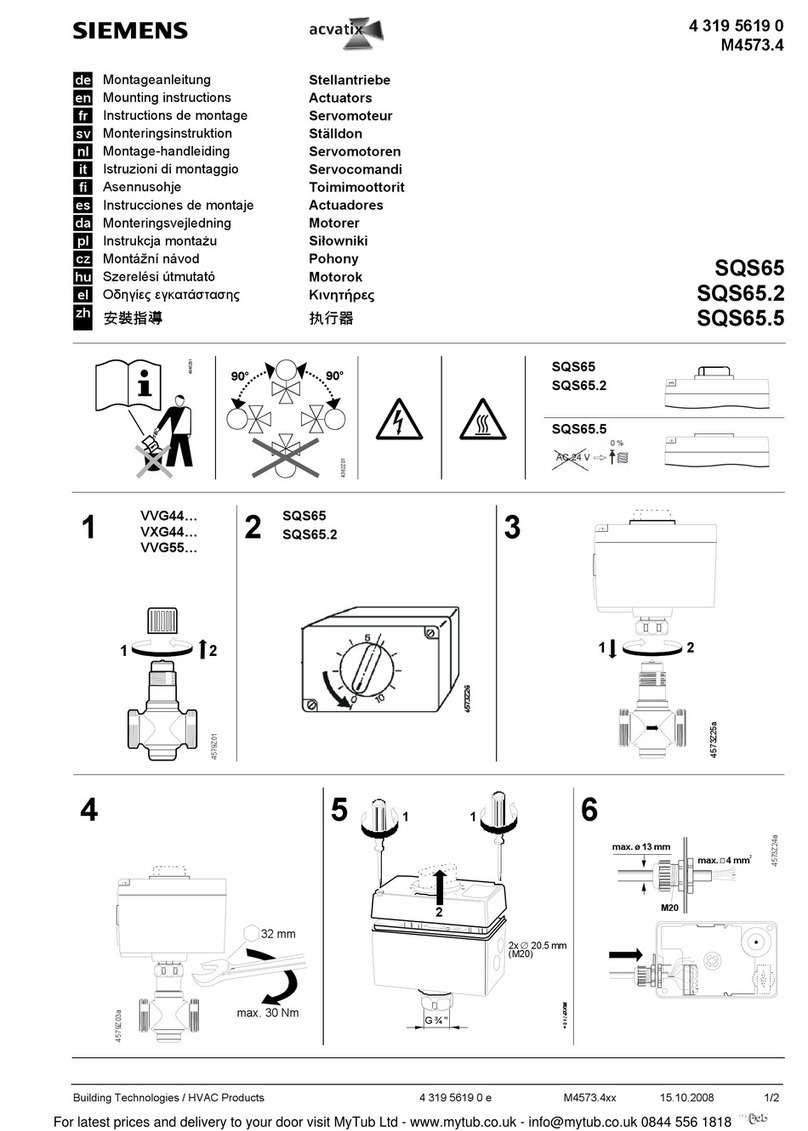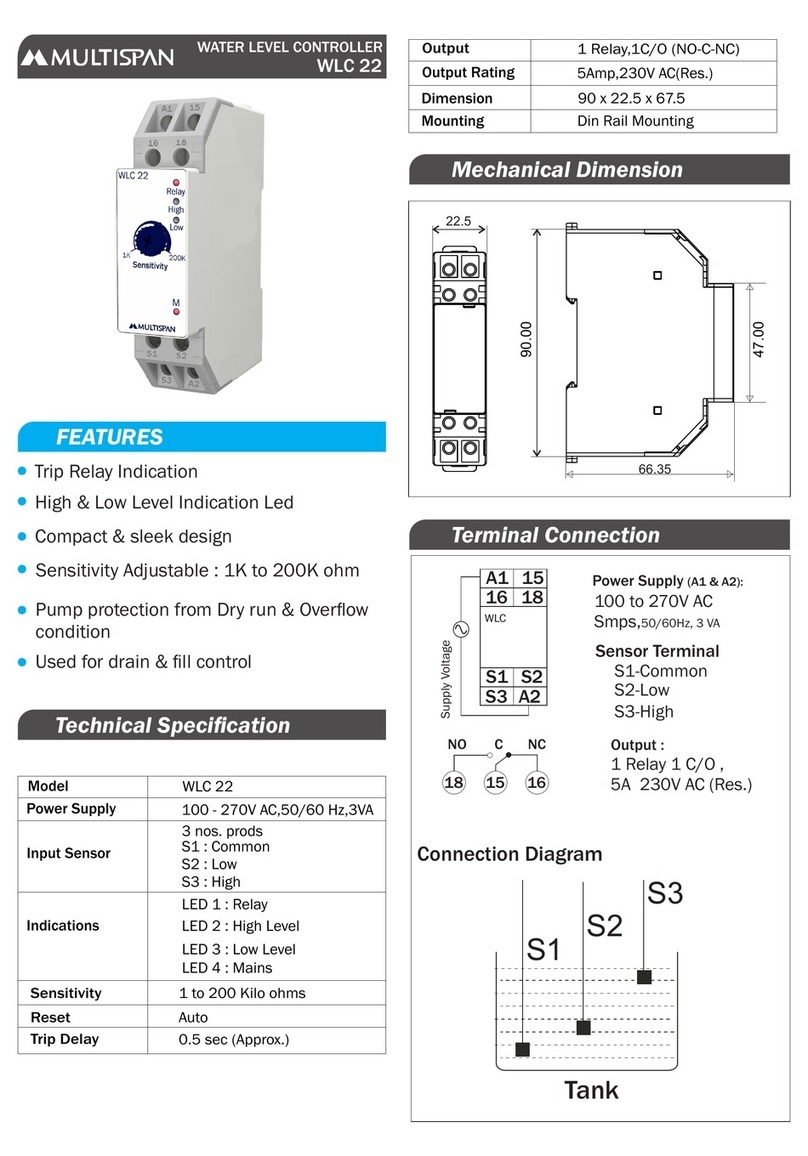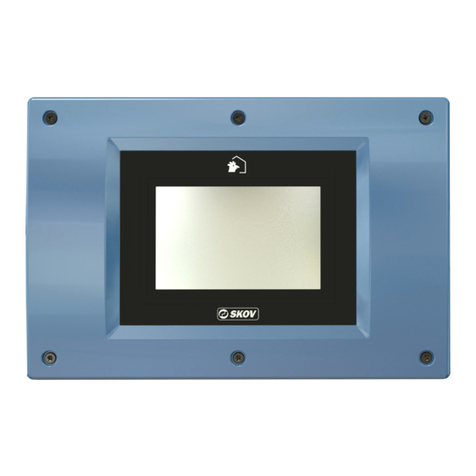IDEC SE9Z-HC User manual

FUNCTION
-
CANCEL
ENTER
+
INSTRUCTION MANUAL
Handy Controller Exclusive for SE4D Series
SE9Z-HC
B-1430(0)
MJE-SE9ZHC No.0027-96V

1
(MEMO)

2
Thank you for purchasing IDEC’s Handy Controller SE9Z-HC exclusive for SE4D series.
Please read both the instruction manual of this manual and SE4D series carefully and thoroughly for
the correct and optimum use of this device.
Kindly keep this manual in a convenient place for quick reference.
This manual has been written for the following personnel who have undergone suitable training and
have knowledge of light curtains, as well as, safety systems and standards (ANSI, etc.).
● who are responsible for the introduction of this device
● who design a system using this device
● who install and connect this device
● who manage and operate a plant using this device
1) All the contents of this instruction manual are the copyright of the publishers, and may not be
reproduced (even extracts) in any form by any electronic or mechanical means (including
photocopying, recording, or information storage and retrieval) without permission in writing
from the publisher.
2) The contents of this instruction manual may be changed without prior notice for further
improvement of the device.
3) A part of / all of this instruction manual or the software may not be copied without permission
from the publisher.
4) Though we have carefully drawn up the contents of this instruction manual, if there are any
aspects that are not clear, or any error that you may notice, please contact our local IDEC
ofce or the nearest distributor.
5) We shall not be responsible for any consequences of use regardless of the descriptions
above.
NOTICE

3
Contents
CHAPTER 1 INTRODUCTION ..............................................................................4
1-1 Attention Marks ..................................................................................................... 4
1-2 Safety Precautions ................................................................................................ 4
CHAPTER 2 GENERAL OUTLINE .......................................................................6
2-1 Features ................................................................................................................ 6
2-2 Part Descriptions .................................................................................................. 6
2-3 Connecting / Setting Procedures .......................................................................... 7
CHAPTER 3 FUNCTIONS ....................................................................................8
3-1 Functional Descriptions ........................................................................................ 8
3-1-1 Fixed Blanking Function.....................................................................................8
3-1-2 Floating Blanking Function.................................................................................9
3-1-3 Auxiliary Output Switching Function...................................................................10
3-1-4 Emission Intensity Control Function...................................................................11
3-1-5 Copy Function ....................................................................................................11
3-1-6 Muting Setting Changing Function .....................................................................11
3-1-7 Interlock Setting Changing Function ..................................................................12
3-1-8 External Device Monitor Setting Changing Function .........................................12
3-1-9 Protective Function ............................................................................................13
3-1-10 Initialization Function .......................................................................................13
3-1-11 Setting Contents Monitoring Function ..............................................................13
3-1-12 Override Setting Changing Function ................................................................13
3-2 Function Setting (Operation Procedure) ............................................................... 14
3-2-1 Fixed Blanking Function.....................................................................................17
3-2-2 Floating Blanking Function.................................................................................18
3-2-3 Auxiliary Output Switching Function...................................................................19
3-2-4 Emission Intensity Control Function...................................................................20
3-2-5 Copy Function ....................................................................................................21
3-2-6 Muting Setting Changing Function .....................................................................22
3-2-7 Interlock Setting Changing Function ..................................................................24
3-2-8 External Device Monitor Setting Changing Function .........................................25
3-2-9 Protective Function ............................................................................................26
3-2-10 Initialization Function .......................................................................................27
3-2-11 Setting Contents Monitoring Function ..............................................................28
3-2-12 Override Setting Changing Function ................................................................29
CHAPTER 4 TROUBLESHOOTING .....................................................................30
CHAPTER 5 SPECIFICATIONS / DIMENSIONS ..................................................31
5-1 Specications ........................................................................................................ 31
5-2 Dimensions ........................................................................................................... 31

4
CHAPTER 1 INTRODUCTION
1-1 Attention Marks
This instruction manual employs the following attention marks , depending on the
degree of the danger to call operator’s attention to each particular action. Read the following
explanation of these marks thoroughly and observe these notices without fail.
Besides, the attention mark is prepared for the helpful information, detail instruction related to each
part, and reference item or page.
If you ignore the advice with this mark, death or serious injury could result.
If you ignore the advice with this mark, injury or material damage could result.
Remarks
The supplementary content is described with this mark.
REFERENCE The related content is described with this mark.
1-2 Safety Precautions
■ Use this device as per its specifications. Do not modify this device since its functions and
capabilities may not be maintained and it may malfunction.
■ This device has been developed / produced for industrial use only.
■ Before using this device, check whether the device performs properly with the functions and
capabilities as per the design specications.
■ In case of disposal, dispose this device as industrial waste.
♦User in charge
● The user in charge has responsible to indicate the person to take the training required for the
safety system, using method, installation, operation, and maintenance.
● This device is used and managed by the specialist, never use this device by other operator.
♦Specialist
● A person who is appropriately educated, has widespread knowledge and experience, and
can solve various problems which may arise during work.
♦Operator
● The operator should read this instruction manual thoroughly, understand its contents, and perform
operations following the procedures described in this manual, for the correct operation of this device.
● In case this device does not perform properly, the operator should report this to the person in
charge and stop the machine operation immediately. The machine must not be operated until
correct performance of this device has been conrmed.

5
♦Fixed blanking function, oating blanking function
● With the xed blanking function, this device prevents the person or object from entering into
the dangerous parts of the machine through the invalid sensing area. However, even though
this device can prevent the interference of the person or object into the invalid sensing area
with the xed blanking function, there might exist the more space between the SE4D series
and already-existence object. Therefore, set the protecting structure so as not to exist any
space in the dangerous sensing area. Detecting human body in the sensing area could result
in death or serious injury.
● With the floating blanking function, this device changes the size of the minimum sensing
object of the SE4D series that is pre-set the function. When setting or changing the
function, calculate and measure the safety distance again, and check that the device has the
wider space than the safety distance between the dangerous parts of the machine and the
sensing area of the SE4D series.
If the sufcient distance is not maintained, the machine will
not stop before its dangerous parts are reached, which can result in death or serious injury.
● Set and change the function of the device following the relative laws, regulation, and
standard without fail.
♦Muting setting changing function
● The muting setting changing function temporarily invalidates safety function of the connected
devices. Conrm all of the applied laws and standards, and install or operate this device and
peripheral devices correctly. Failure to do so, the operator may suffer a serious injury.
♦Environment
● Do not use a mobile phone or a radio phone near this device.
● Do not use this device in the following environments.
1) Areas with high humidity where condensation is likely to occur
2) Areas exposed to corrosive or explosive gases
3) Areas exposed to vibration or shock of levels higher than that specied
4) Areas exposed to contact with water
5) Areas exposed to too much steam or dust
♦Wiring
● Be sure to carry out the wiring in the power supply OFF condition.
● All electrical wiring should conform to the regional electrical regulations and laws. The wiring
should be done by engineer(s) having the special electrical knowledge.
● Do not run the wires together with high-voltage lines or power lines or put them in the same
raceway. This can cause malfunction due to induction.
♦Maintenance
● Clean this device with a clean cloth. Do not use any volatile chemicals.
♦Other
● Never reassemble or remodel this device.
INTRODUCTION

6
CHAPTER 2 GENERAL OUTLINE
This chapter gives the system construction, part description, etc. of this device.
2-1 Features
This device is the handy controller for setting each function of the light curtain SE4D
series.
Besides, this device performs the checking and copying the setting contents of the
function, and protection of writing.
<Functions>
● Fixed blanking function
● Floating blanking function
● Auxiliary output switching function
● Emission intensity control function
● Copy function
● Muting setting changing function
● Interlock setting changing function
● External device monitor setting changing function
● Protective function
● Initialization function
● Setting contents monitoring function
● Override setting changing function
2-2 Part Descriptions
FUNCTION
-
CANCEL
ENTER
+
Male connector
Cable (0.5m)
FUNCTION indicator × 9
(Green)
FUNCTION switch
Digital display (Red)
+ switch
ENTER switchCANCEL switch
- switch
Female connector

7
Connecting / Setting Procedures
2-3 Connecting / Setting Procedures
This section describes the connecting / setting procedures for both this device and SE4D series.
1. Set the SE4D series, and check that the
SE4D series works properly. For mounting
method of SE4D series, refer to the
Instruction Manual.
2. Turn OFF the power and connect this
device to the SE4D series. Use the handy
controller connection cable (SE9Z-WNC1)
for the connection. The handy controller
connection cable (SE9Z-WNC1) can be
connected by connecting the included
SE9Z-CCJ02-HC1 to the device’s female
connector.
3. Turn ON the power, and set the function with this device.
After the power of this device is ON, approx. 30 sec. will be taken for data transmission with SE4D
series. While data transmission, “ ” lights up in revolving.
The control output (OSSD 1 / 2) of SE4D series is set to “OFF” while this device has been
connected.
REFERENCE Refer to “3-1 Functional Descriptions” for the details of the functions, and refer to “3-2
Function Setting (Operation Procedure)” for the setting procedures of the functions
respectively.
4. Turn OFF the power, then remove this device.
5. Check that the SE4D series works as set at the procedure 3.
Then, inspect the SE4D series.
REFERENCE Refer to “Chapter 4 Maintenance” of the SE4D series instruction manual for the details of
the inspection of the SE4D series.
<For PNP output> <For NPN output>
24V±10% +
-
Emitter
Receiver
(Shield)
(Blue)
(Brown)
(Orange)
(Orange
/ Black)
(Blue)
(Brown)
(Orange)
(Orange
/ Black)
(Shield)
(Blue)
(Brown)
(Orange)
(Orange / Black)
24V±10% +
-
Emitter
Receiver
(Shield)
(Blue)
(Brown)
(Orange)
(Orange
/ Black)
(Blue)
(Brown)
(Orange)
(Orange
/ Black)
(Shield)
(Blue)
(Brown)
(Orange)
(Orange / Black)
Handy controller connection
cable (SE9Z-WNC1)
This device
SE9Z-CCJ02-HC1
Female
connector
Handy controller connection
cable (SE9Z-WNC1)
This device
SE9Z-CCJ02-HC1
Female
connector

8
CHAPTER 3 FUNCTIONS
If conguration of the system is changed (replace the SE4D series etc.), set the function
again.
3-1-1 Fixed Blanking Function
This is a function that the control output (OSSD 1 / 2) of SE4D series is not turned OFF, even if the
specied beam channel(s) is blocked OFF.
This is useful when an obstacle always blocks OFF the specic beam channel(s).
There are “Clear,” “Auto” and “Manual” for the setting method.
● Clear setting : The xed blanking function is to be invalid (factory setting).
● Auto setting : The currently blocked OFF beam channels are set as “effective beam channels”
in the xed blanking function. Be sure to set this function in the state where the
emitter emits light. Furthermore, this function cannot be set in the state where all
beam channels receive lights / are blocked.
● Manual setting : Each beam channel can be set to “effective / ineffective” in the fixed blanking
function respectively.
3-1 Functional Descriptions
When the xed blanking function is used, the control output (OSSD 1 / 2) of SE4D series
is not turned OFF even if the particular beam channels are blocked.
By using a protection structure etc., make the dangerous parts of the machine inaccessible
to personnel through the sensing area of the particular beam channels.
<Before measures>
<After measures>
Obstacle
Dangerous area
Protection structure
Beam channels the xed blanking
function has been set to ON
Beam channels the xed blanking
function has been set to ON
Emitter
Receiver
Emitter
Receiver
When the effective beam channel(s) in the xed blanking function receive(s) the beam(s)
from the emitter, the control output (OSSD 1 / 2) of the SE4D series is xed to “OFF.” In
this case, check the mounting condition and turn the power ON again.
(Even if the power is turned ON again, the xed blanking function still stays effective.)
When the xed blanking function is used, the received light intensity indicator of SE4D
series is turned OFF regardless of the received light intensity.

9
Functional Descriptions
3-1-2 Floating Blanking Function
This function is set in each SE4D series.
If the number of the blocked beam channels is less than the set number of the beam channels, the
control output (OSSD 1 / 2) of SE4D series is not turned “OFF.”
This function is useful when an obstacle moves within the sensing area.
The factory setting of this function is “ineffective.”
The following items can be set.
Set number of beam channels
● Selectable among 0 (the oating blanking function is ineffective), 1, 2 or 3.
Ineffective setting of both end beam channel
● “Effective / ineffective” of the oating blanking function for the both end beam channels can be
selected.
• SET (Effective) : The floating blanking function becomes ineffective for the both end beam
channels. In case either end of the beam channel is blocked, the control
output (OSSD 1 / 2) of SE4D series is turned “OFF” regardless of the set
number of the beam channels.
• CLR (Ineffective) : The floating blanking function becomes effective for all beam channels
including both end beam channels.
Non-serial beam channel setting
• SET (Effective) : Even if the beam channels are blocked discontinuously in the set beam
channels, the control output (OSSD 1 / 2) of SE4D series is turned “ON.”
(Discontinuous mode)
• CLR (Ineffective) : When the beam channels are blocked discontinuously even in the set beam
channels, the control output (OSSD 1 / 2) of SE4D series is turned “OFF.”
(Continuous mode)
[For use in Europe (EU) (as EN 999)] (Also applicable to ISO 13855)
(For intrusion direction perpendicular to the sensing area)
<In case that the minimum sensing object is ø40mm or less>
● Equation S = K × T + C
S : Safety distance (mm)
Minimum required distance between the sensing area surface and the dangerous parts of
the machine.
K : Intrusion velocity of operator’s body or object (mm/sec.)
Taken as 2,000 (mm/sec.) for calculation
T : Response time of total equipment (sec.)
T = Tm + TSE4D
Tm: Maximum halting time of machine (sec.)
TSE4D: Response time of SE4D series (sec.)
C : Additional distance calculated from the size of the minimum sensing object of the SE4D
series (mm)
However, the value of C cannot be under 0.
C = 8 × (d - 14)
d: Diameter of the minimum sensing object (mm)
● When using the floating blanking function, the size of the minimum sensing object
becomes larger, and the safety distance is longer as well. For the calculation of the
safety distance, refer to the instruction manual enclosed with SE4D series.
● Before designing the system, refer to the relevant laws and standards of the region
where SE4D series is to be used and then install SE4D series.
● The minimum sensing object differs depending on the set number of the beam channels.

10
Functional Descriptions
<Minimum sensing object>
Floating blanking function
Ineffective Effective
1 beam channel 2 beam channels 3 beam channels
SE4D-H□ ø25mm ø45mm ø65mm ø85mm
3-1-3 Auxiliary Output Switching Function
This function changes the operation state of the auxiliary output. It is useful when desired to make an
indicator to operate or inform the operation state of the SE4D series to PLC.
The following settings are selectable.
Setting
mode Auxiliary output setting
Operation of the auxiliary output corresponding to SE4D series state
Emission
halt
State of sensing area when emitting
Lockout
Unshielded
Shielded
Unstable
light-receiving
condition
Others
0
Negative logic of the control
output (OSSD 1 / 2)
(factory setting)
ON OFF when OSSD is ON
ON when OSSD is OFF ON
1Positive logic of the control
output (OSSD 1 / 2) OFF ON when OSSD is ON
OFF when OSSD is OFF OFF
2 ON when emitting OFF ON OFF
3 OFF when emitting ON OFF ON
4OFF under unstable light
receiving condition (Note 1) (Note 3) OFF ON (Note 3) (Note 3)
5ON under unstable light
receiving condition (Note 1) (Note 3) ON OFF (Note 3) (Note 3)
6 ON during muting OFF ON during muting
Others: OFF OFF
7 OFF during muting ON OFF during muting
Others: ON ON
8
ON in light receiving condition
(Note 2) OFF ON OFF OFF
9
OFF in light receiving condition
(Note 2) ON OFF ON ON
Notes: 1) When the xed blanking function, the oating blanking function or the muting function is used, the setting of ON / OFF
under unstable light-receiving condition does not work.
2) By the setting of ON / OFF in light receiving condition, light-receiving / light interrupted condition is output regardless of
the xed blanking function, the oating blanking function or the muting function.
<e.g.>
When the fixed blanking function is used, if an obstacle exists in the set area and other area is in light receiving
condition, the control output (OSSD 1 / 2) is in ON sate, however, the auxiliary output becomes OFF since the SE4D
series has been detecting the obstacle.
3) The state of the auxiliary output remains the same even if the SE4D series state changes.
If the oating blanking function is used, the incident light intensity indicator is turned OFF
when an obstacle exists in the sensing range regardless of the incident light intensity.
Do not use the auxiliary output for the purpose of stopping the machine in which the SE4D
series is installed. Failure to do so could result in death or serious injury.

11
Functional Descriptions
3-1-4 Emission Intensity Control Function
This function reduces the emitting intensity.
It is useful for preventing interference from the emitter to the other devices.
Emission intensity control
• CLR (Ineffective) : Operating range is 0.3 to 9m for SE4D-H□ (12 to 64 beam channels), 0.3 to
7m for SE4D-H□ (72 to 96 beam channels) (factory setting).
• SET (Effective) : The operating range is reduced by approx. 50%.
3-1-5 Copy Function
This is a function to copy the setting of a SE4D series to other SE4D series.
This function is available only under the same system configuration (the number of sensors, the
number of beam channels, same model No.).
All functions that are settable with this device can be copied.
Note that the password is also copied with this function.
The following operations are available with this function.
● Upload : Upload the functional setting data of SE4D series to this device.
● Download : Download the functional setting data of this device to SE4D series.
● Monitoring : Check the functional setting data saved in this device.
This device
SE4D series
Copied
SE4D series
Copied
SE4D series
Original
Upload Download
(Storage area for SE4D series)
3-1-6 Muting Setting Changing Function
The setting of the muting function can be changed.
Setting of the muting function on each beam channel
● Each beam channel can be set to “effective / ineffective” in the muting function respectively. (Note)
● The factory setting of this function is effective for all beam channels.
Note: If the beam channel set to ineffective in the muting function is blocked, the control output (OSSD 1 / 2) becomes “OFF” and
the muting function is canceled.
● There are two setting methods, “Auto” and “Manual” to set muting beam channel.
• Auto setting : The beam channel which is currently blocked is set as the “effective” beam
channel. When all beam channels are in light receiving condition, the setting is
not accepted. Furthermore, in the state where emission is halted or all beam
channels are blocked, the all beam channels become “effective” in the muting
function.
• Manual setting : Each beam channel can be set to “effective / ineffective” in the muting function.
ON: The muting function is effective
OFF: The muting function is ineffective

12
Functional Descriptions
Muting input conditions
● The order for inputting the muting input A and B, which the muting function activates, can be set.
A = b: Effective even either comes rst
A b: Effective only when the input A comes rst
b A: Effective only when the input B comes rst
Note: The setting is possible for each channel.
Setting of the muting lamp diagnosis function
● The muting lamp diagnosis function can be set to “effective / ineffective.” (Note)
The factory setting of this function is effective.
ON : The muting lamp diagnosis function is effective.
OFF : The muting lamp diagnosis function is ineffective.
Note: If the muting lamp diagnosis function is set to ineffective, the muting function is maintained even if the lamp blew.
Muting sensor output operation setting
● Output operation of the muting sensor can be selected.
The factory setting is NONO (Normally Open, Normally Open).
• NONO (Normally Open, Normally Open)
A muting sensor which is to be connected to the muting input A (ON with light non-received
status, ON with object approaching status and ON with object contacted status)
A muting sensor which is to be connected to the muting input B (ON with light non-received
status, ON with object approaching status and ON with object contacted status)
• NONC (Normally Open, Normally Closed)
A muting sensor which is to be connected to the muting input A (ON with light non-received
status, ON with object approaching status and ON with object contacted status)
A muting sensor which is to be connected to the muting input B (ON with light received status,
ON with object non-approaching status and ON with object non-contacted status)
3-1-7 Interlock Setting Changing Function
One condition can be selected from the following three interlock conditions. It can be set to invalid,
too. (Mode 3)
• Start / Restart interlock (Mode 0)
The SE4D series goes into interlock condition after the power is ON and when it is in the light
receiving condition.
The factory setting is Start / Restart interlock.
• Start interlock (Mode 1)
The SE4D series goes into interlock condition only when the power is ON. Once the SE4D
series is reset, it does not go into interlock condition again.
• Restart interlock (Mode 2)
The SE4D series does not go into the interlock condition when the power is ON.
The SE4D
series goes into interlock condition only when the SE4D series receives the light, after the
power is ON, the control output (OSSD 1 / 2) is turned into ON once and then the SE4D series
is blocked.
3-1-8 External Device Monitor Setting Changing Function
The setting of the external device monitor can be changed.
1. Allowable period of the response time: 100 to 600ms (unit of 10ms)
The factory setting is 300ms.
2. “Effective / ineffective” of the external device monitor function can be selected.
The factory setting is “effective.”

13
Functional Descriptions
3-1-9 Protective Function
The functional settings are not allowed to change without the input of a password.
When the protective function is set to “effective,” the setting can be changed by inputting the password.
The setting contents monitor function can be used regardless of the protective function “effective / ineffective.”
The password should be a 4-digit number from 0 to 9. (The password of the factory setting is “0000.”)
The protective function is set on the receiver side.
3-1-10 Initialization Function
The settings can be initialized. (factory setting) (Note)
The factory setting of each function is as follows.
Function Setting
Fixed blanking function Ineffective
Floating blanking function Ineffective
Auxiliary output switching function Mode 0
Emission intensity control function Normal mode
Muting setting
changing
function
Setting of the muting function on each beam channel Effective for all beam channels
Muting input conditions A = B
Setting of the muting lamp diagnosis function Effective
Muting sensor output operation setting NONO
Interlock setting changing function Start / Restart
External devise monitor setting changing function Effective / 300ms
Override setting changing function 60 sec.
Note: The setting of the protective function and the setting data of the copy function are not initialized.
3-1-11 Setting Contents Monitoring Function
Each setting of the SE4D series can be monitored. The following can be monitored.
● Model No. / the number of beam channels
● Setting of the xed blanking function (Reading out the record of the latest 5 times is possible)
● Setting of the oating blanking function (Reading out the record of the latest 5 times is possible)
● Setting of the auxiliary output switching function
● Setting of the emission intensity control function
● Setting of the muting setting changing function
(Reading out the record of the latest 5 times is possible, however, only for setting beam channel.)
● Setting of the interlock setting changing function
● Setting of the external device monitor setting changing function
● Override setting changing function
3-1-12 Override Setting Changing Function
Maximum continuous effective time set at the override function can be changed.
The maximum continuous effective time can be set in the range of 60 to 600 sec. (in units of 10 sec.).
The factory setting is 60 sec.
● When the protecting function is set to “ineffective,” the third person may change the
setting. It is recommended that the protecting function should be set to “effective” so as
not to change the setting by the third person.
● Take sufcient care not to forget the set password. In case you forget the password,
please contact us.

14
Function Setting
3-2 Function Setting (Operation Procedure)
This section describes the setting of each function (operation procedure).
<Selecting the setting item>
Select a setting item with FUNCTION or CANCEL switch, and conrm it with ENTER.
****
****
****
****
****
****
****
****
****
To “3-2-1 Fixed Blanking Function”
To “3-2-2 Floating Blanking Function”
To “3-2-3 Auxiliary Output Switching Function”
To “3-2-4 Emission Intensity Control Function”
To “3-2-5 Copy Function”
To “3-2-6 Muting Setting Changing Function”
To “3-2-7 Interlock Setting Changing Function”
To “3-2-8 External Device Monitor Setting Changing Function”
To “3-2-9 Protective Function”
To “3-2-10 Initialization Function”
To “3-2-11 Setting Contents Monitoring Function”
To “3-2-12 Override Setting Changing Function”
key operation
: FUNCTION
: ENTER
: CANCEL
: -
: +
“****” indicates the connection state of the system.
● “ ”: Used when connected to the SE4D series.

15
Function Setting
<Inputting a password>
When the protective function is effective, “Lock” is shown on the lower section of the digital display.
The functional settings of the SE4D series cannot be changed unless the password is input.
Note that
“3-2-9 Protective Function” is “locked” even when the protective function is ineffective.
Remarks
1) “3-2-11 Setting Contents Monitoring Function” is not “locked.”
2) Once the password is input, you do not need to input the password again till the power is
turned OFF. (Except “3-2-9 Protective Function”) However, if the power is turned ON again
without changing the protective function to ineffective, the password have to be input again
since the protective function is still effective.
The procedure for inputting a password is as follows.
Input password
CH1
CH2
CH3
Complete inputting password
NG
NG
NG
Complete inputting password for 1 unit
Complete inputting password for 2 units

16
<Selecting sensor>
Each function can be set on each SE4D series connected in series as well. Select a SE4D series to
set each function.
Remarks
Since “3-2-5 Copy Function” and “3-2-9 Protective Function” are set collectively, it is not
necessary to select a sensor. Furthermore, when a SE4D series unit is used, CH2 / CH3 cannot
be selected. When two SE4D series in series connection are used, CH3 cannot be selected.
“3-2-3 Auxiliary Output Switching Function,” “3-2-7 Interlock Setting Changing Function” or
“3-2-8 External Device Monitor Setting Changing Function” is set with CH1 only. CH2 and
CH3 are not indicated.
Function Setting
*: When the units are not in series connection, it is not indicated.
CH3 (Sub sensor 2)
CH2 (Sub sensor 1)
CH1 (Main sensor)
ALL (All sensor) (*)
Emitter
Receiver
Emitter
Receiver
Emitter
Receiver

17
Function Setting
3-2-1 Fixed Blanking Function
(Sub sesnor 2)
1. Fixed blanking
function
2. To Floating
blanking
function
Select function
(Ineffective)
(Clear setting)
(Effective)
(Auto setting)
(Effective)
(Manual setting)
(All sensors)
(Main sensor)
(Sub sesnor 1)
Select sensor
(Clear setting) Send
(Error)
To 1
Input
password
OK
NG
(Sub sensor 2)
(Main sensor)
(Sub sensor 1)
(Effective)
(Ineffective)
(Auto setting) Send
(Error)
To 1
To 1
To 2
Select sensor Check result
Keep pressing
switch OK
It is possible to
check ON / OFF of
all beam channels
Input
password
OK
NG
Select “send”
(Error)
To 1
Send
Input
password
Select beam channel
Setting
Manual
setting
OK
NG
Once a password
is input, it is not
necessary to input
it again till the
power is turned
OFF.
Beam channel No.
First beam
channel
Second beam
channel
Effective beam
channel
Ineffective beam
channel
The beam channel No. is given with 1, 2, 3・・・from
the bottom.
Beam channel No.
3
2
1
Beam channel
No.
Emitter
Receiver
*: The functional setting for each beam channel is as follows.
on : The xed blanking function is effective.
oFF : The xed blanking function is ineffective.
key operation
: FUNCTION
: ENTER
: CANCEL
: -
: +

18
Function Setting
3-2-2 Floating Blanking Function
FLO1 <Effective setting of beam channel>
0: Ineffective
1: 1 beam channel setting
2: 2 beam channels setting
3: 3 beam channels setting
FLO2 <Ineffective setting of both end beam channel>
SET (Effective) : Both ends of the beam channels are not subject to the oat blanking function
CLR (Ineffective) : All beam channels are subject to the oating blanking function
FLO3 <Non serial beam channel setting>
SET (Effective) : Non-serial beam channel mode
CLR (Ineffective) : Serial beam channel mode
Note: When “all sensors” is selected in the sensor selection, the setting of the oating blanking function on each SE4D series
should be identical.
(Sub sensor 2)
Sensor selection
(All sensors)
(Main sensor)
(Sub sensor 1)
Set No. of beam channel
(Ineffective)
Input
password
Send
(Error)
To 2
OK
NG
To 2
Send
(Error)
OK
NG
(Ineffctive)
(Effctive)
(Ineffctive)
(Note)
(Effctive)
Ineffective setting
for both ends
beam channels
Setting for
non-serial beam
channel
One beam
channel effecive
Two beam
channel effecive
Three beam
channel effecive
3. To Auxiliary
output switching
function
2. Floating blank-
ing function
key operation
: FUNCTION
: ENTER
: CANCEL
: -
: +

19
Function Setting
3-2-3 Auxiliary Output Switching Function
*: When two or more SE4D series are connected, cancel the protective function of all SE4D series.
<Setting of the auxiliary output>
Mode 0: Negative logic of the control output (OSSD 1 / 2) (factory setting)
Mode 1: Positive logic of the control output (OSSD 1 / 2)
Mode 2: ON during emission, OFF when emission is not done.
Mode 3: OFF during emission, ON when emission is not done.
Mode 4: OFF when the received light level is unstable (Note 1)
Mode 5: ON when the received light level is unstable (Note 1)
Mode 6: ON during muting
Mode 7: OFF during muting
Mode 8: ON in the light receiving condition
Mode 9: OFF in the light receiving condition
Notes: 1) This cannot be used when the xed blanking function, the oating blanking function or the muting setting changing
function is used.
2) When using with SE4D series only, if the external device monitor function is not used, set the monitor setting to
ineffective in “3-2-8 External Device Monitor Setting Changing Function.”
(Mode 9)
4. To Emission intensity
control function
Select output
(Mode 0)
(Mode 1)
(Mode 2)
Send
(Error)
To 3
OK
NG
・・・
Input pass-
word (*)
3. Auxiliary output
switching function
key operation
: FUNCTION
: ENTER
: CANCEL
: -
: +
Table of contents
Other IDEC Controllers manuals
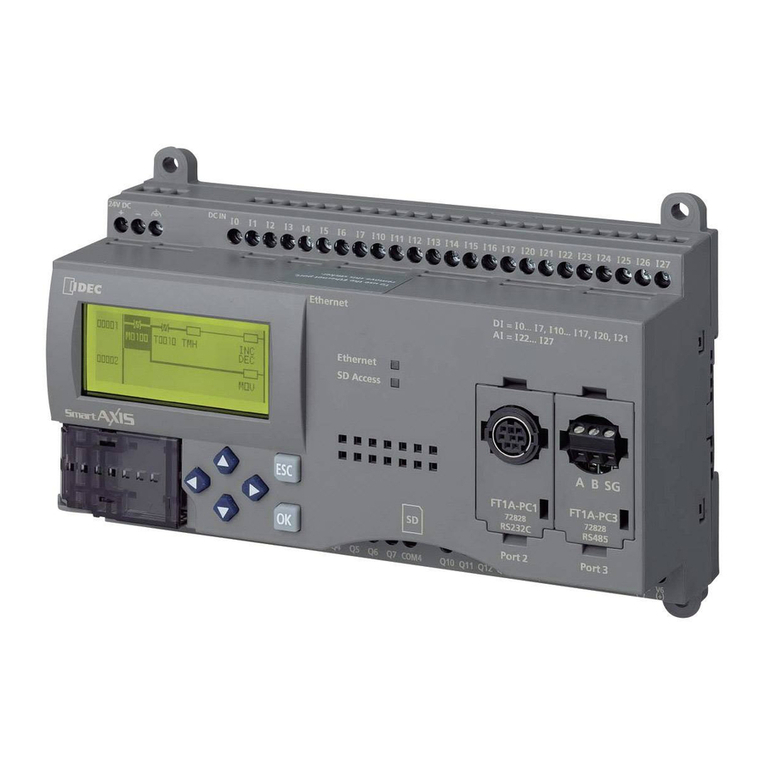
IDEC
IDEC SmartAXIS Touch FT1A Series User manual
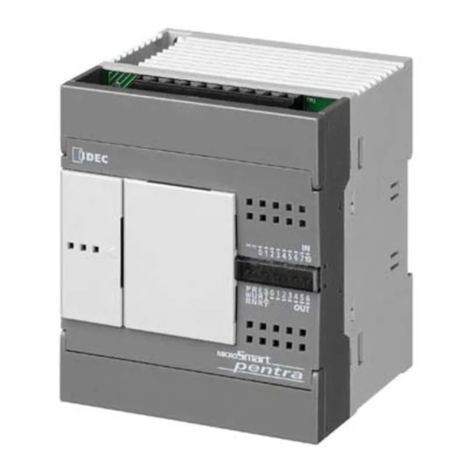
IDEC
IDEC MICROSmart FC5A Series User manual
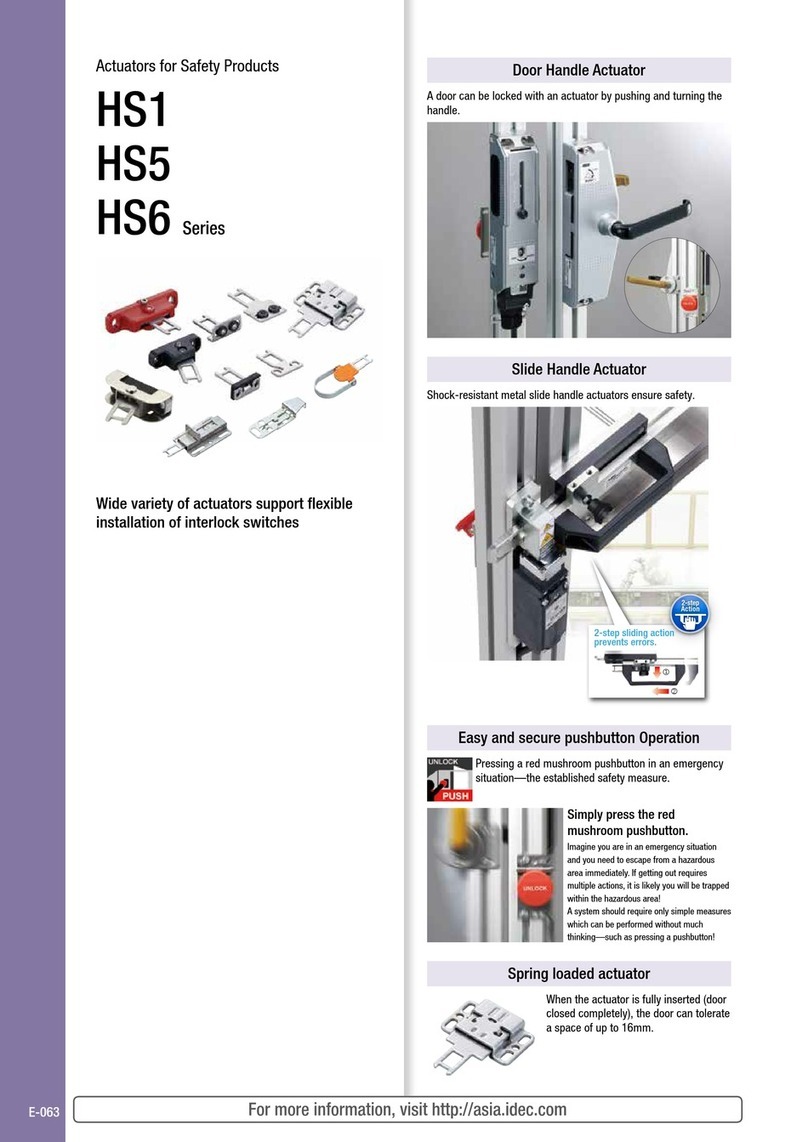
IDEC
IDEC HS1 Series User manual
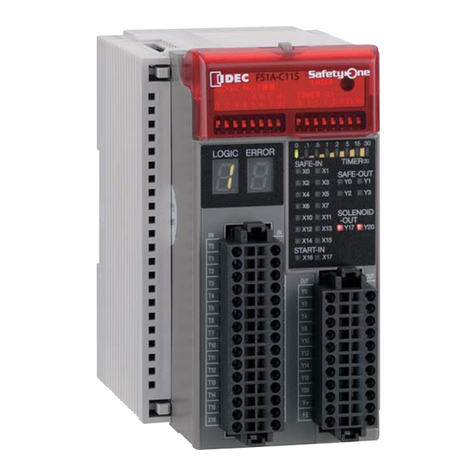
IDEC
IDEC FS1A-C11S User manual
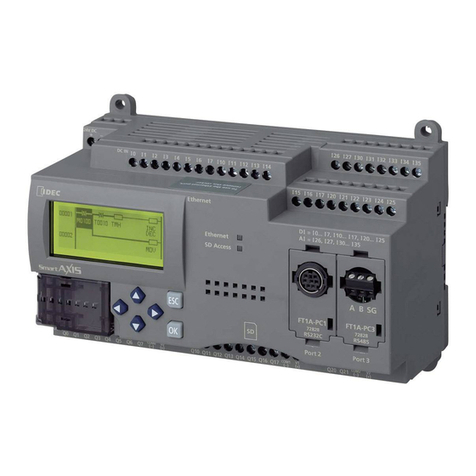
IDEC
IDEC SmartAXIS Touch FT1A Series User manual
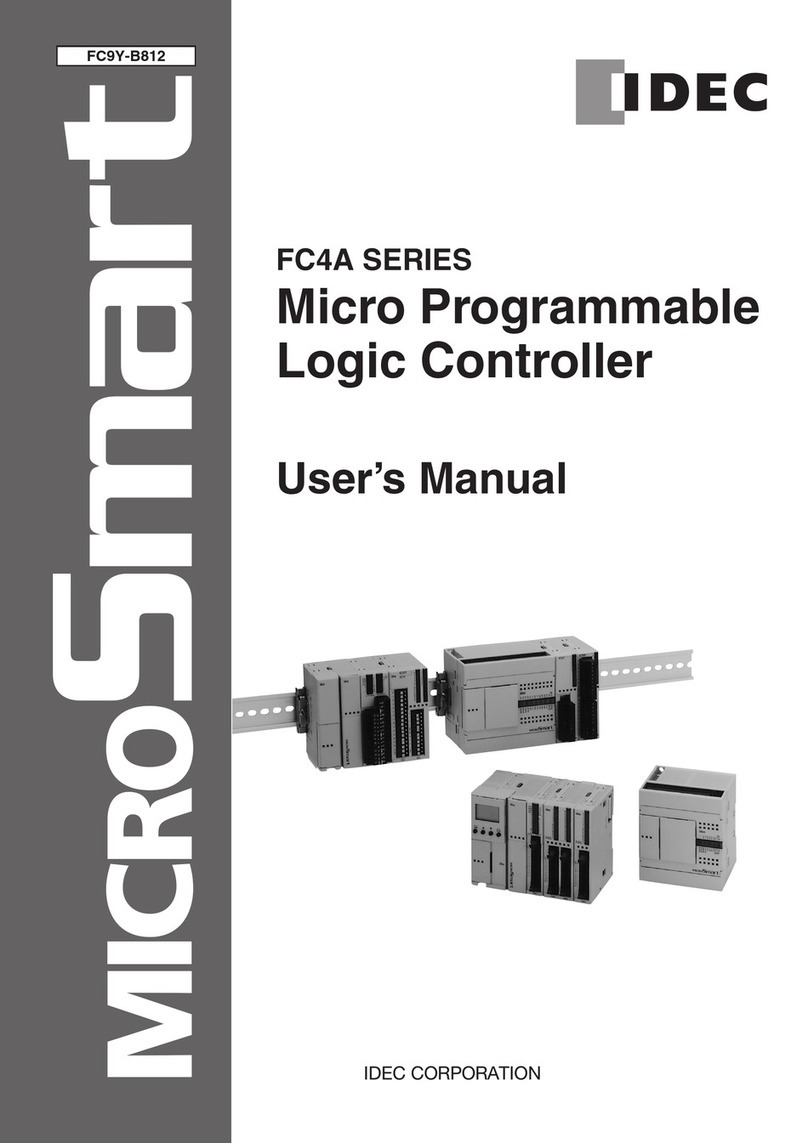
IDEC
IDEC FC4A-C10R2 User manual
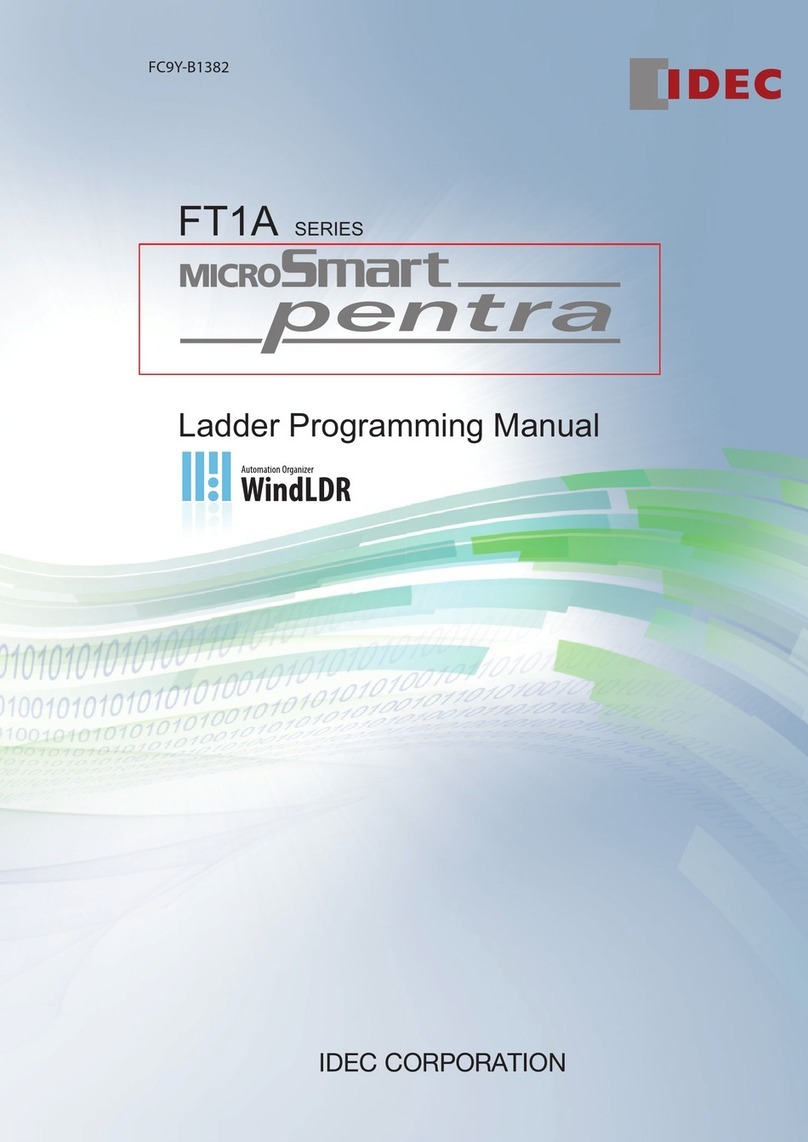
IDEC
IDEC microsmart pentra Owner's manual

IDEC
IDEC HS9Z-FL54 User manual
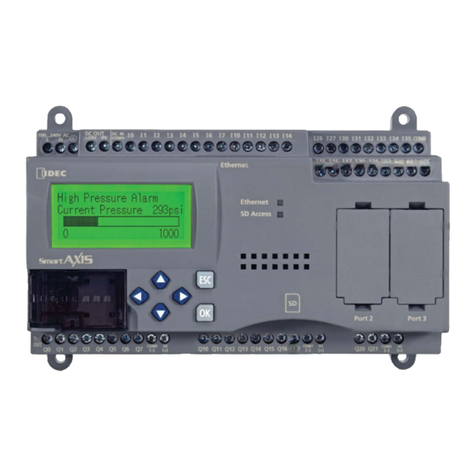
IDEC
IDEC SmartAXIS Touch FT1A Series User manual
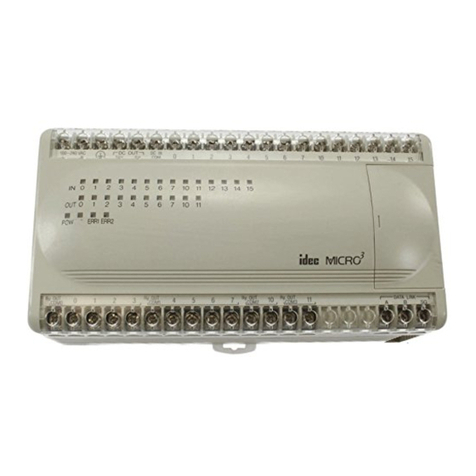
IDEC
IDEC MICRO3C User manual
